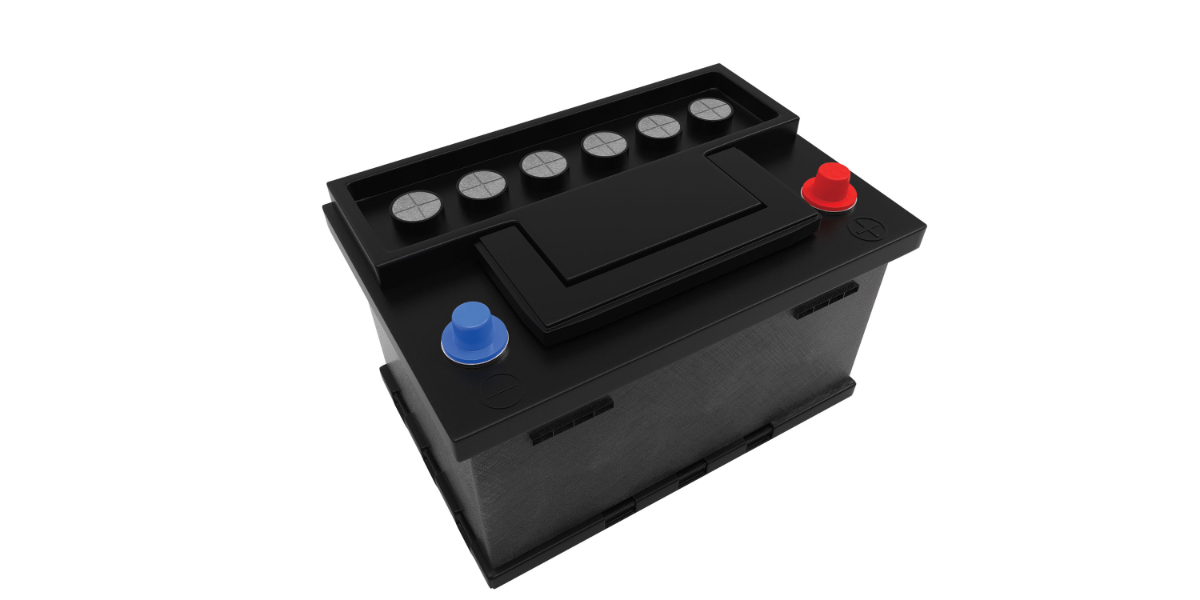RV Tire Basics
Image Caption:
Tires on tow vehicles or trailers run the gamut from passenger-car types to truck and trailer rubber — and each has its own specific design, construction and job to do. Problems with tires are a common subject of discussion, so let’s learn how to get the most out of those expensive black-rubber doughnuts.
Tire Size
Tires for trailers, tow vehicles and motorhomes come in a wide variety of sizes to fit the wheel diameters and widths used by various manufacturers over the years. Three tire-sizing systems are used on current pickups, SUVs and vans: Euro-metric, P-metric (passenger metric) and LT-metric (light truck metric). Many so-called half-ton vehicles use Euro-metric and P-metric-size tires, while heavy-duty trucks use LT-metric-size tires.
The metric standard of trailer and truck tire sizing uses three numbers followed by a slash, then two more numbers, then an R for radial or B for bias, then more numbers. Using 235/80R16, for an example, the tire would be 235 millimeters wide, with an aspect ratio of 80 (80 percent as tall as it is wide), and the 16 is the rim diameter in inches.
Euro- and P-metric tires offer lighter weight, lower rolling resistance and smoother riding, and have more fuel-efficient tread designs than typical LT tires. Both Euro- and P-metric tires in the same size (for example, 225/80R16 and P225/80R16) are equivalent in dimensions and have only slight differences in load-capacity calculations and load-inflation tables. Therefore, if Euro- and P-metric tires share the same numeric size, the same tire performance category and the same speed rating, the two are considered equivalent and interchangeable, if used in axle pairs or full sets.
SUVs and vans have higher centers of gravity and a higher probability of being overloaded than passenger cars. Therefore, a Euro- or P-metric tire rated to carry 2,000 pounds on a passenger car would be down rated to 1,820 pounds when fitted to a pickup or SUV for safety reasons. Depending on the road and weather conditions, you may need tires on your two-wheel-drive tow vehicle (or motorhome) that have different tread designs on the front and back tires. In many cases, a straight-rib highway tire works best on the front, and this type of tread has the lowest rolling resistance and best wear. If you plan to drive only in mild weather and on good roads, straight-rib highway tires at the rear will also give the best mileage and fuel economy. If you expect to drive in muddy conditions or snow, tires with lug or traction patterns should be used on the rear. All-wheel-drive and 4×4 vehicles must have tires that all match.
For any given size, the higher the load range (or ply rating), the more weight the tire can carry. How much weight depends on the size and construction of the tire, and the inflation pressure. In general, the cumulative maximum load capacity of the tires on a tow vehicle or RV should meet or exceed the maximum load rating (total weight of the vehicle plus fuel, cargo, passengers, etc.). Wheels must also be rated to meet or exceed this rating.
Load distribution is also critical in determining the maximum load carried by tires. Trailers and motorhomes often have uneven weight distribution due to slideout rooms, tank locations, etc. It’s important to keep the weight as balanced as possible so the tires each carry a proportionate load. If the load is unbalanced, all tires on that axle should be inflated for the highest weight on any tire on that axle. This is why it is important to weigh the rig, full of water, propane and all supplies, to determine how the weight is distributed. More on this later.
Older tire designs used diagonal or bias-ply construction, whereas most modern tires use radial construction. Radial inner belts cross the tire tread perpendicularly, and the shoulders tend to have a rounder shape than bias-type tires. Radials also tend to have lower rolling resistance and last longer than bias-ply designs. Belts may be made of metal or synthetic cords such as polyester.
Radials and bias-ply tires have different handling characteristics and should not be mixed. Goodyear, for example, recommends using the same size and type of tire on the same axle — that is, all radial ply or bias ply, all the same size and tread pattern — as well as approximately the same tread depth. If you decide to change to radials, do all positions at the same time.
Manufacturers also vary rubber compounds by mixing various components such as silica, carbon black and other chemicals. This allows tires to be designed for different types of vehicles, driving styles and weather, with a good balance between wear and traction. Harder compounds wear longer but have less grip, and vice versa.
Special Trailer Tires
Tires designated ST, which stands for Special Trailer, are designed for the specific needs of trailers. Trailer tires do not have to steer or propel a vehicle, so drive traction is not a consideration; therefore, tread patterns are designed for low rolling resistance. However, trailer tires do have to carry a lot of weight and endure outside storage and weathering for extended periods.
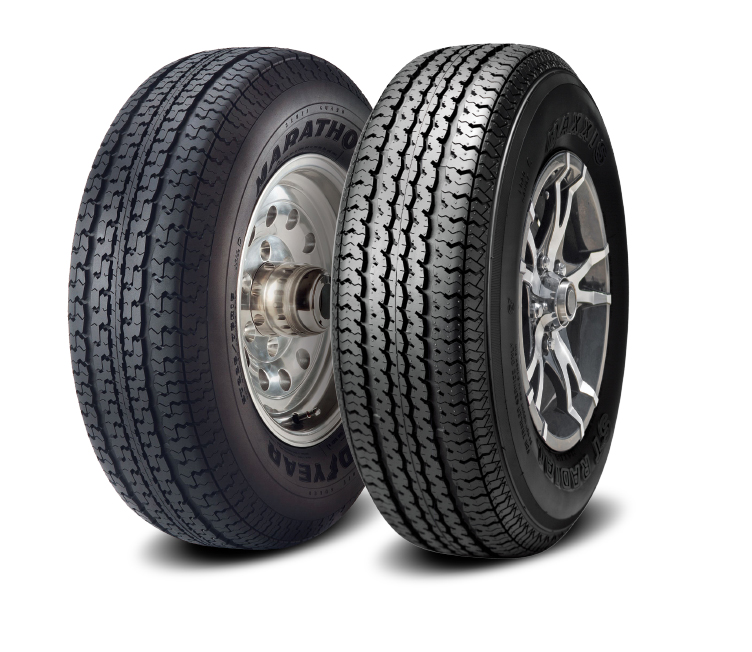
ST (Special Trailer) tires, like these from Goodyear and Maxxis, are available for travel trailers and fifth-wheels, as well as folding campers.
ST tires utilize materials and construction needed to handle the higher loads trailers present. ST rubber compounds typically incorporate more chemicals to resist UV rays and aging, and may also use harder rubber than drive wheel and steering tires. ST tire sidewalls are designed to keep the tire from rolling off or under the rim during tight turns. Cords used in ST tires are larger than those in comparable Passenger (P) or Light Truck (LT) tires. Typically, the steel wires also have higher tensile strength to handle the additional loads. This heavier construction is why ST tires are typically rated to carry more load (for a given size) than LT tires.
Another important distinction between LT and ST tires is their speed ratings — something a lot of RVers tend to overlook. Goodyear, maker of Marathon trailer tires, states in its bulletin PSB 2011-13: “Industry standards dictate that tires with the ST designation are speed rated at 65 mph under normal inflation and load conditions. Based on these industry standards, if tires with the ST designation are used at speeds between 66 and 75 mph, it is necessary to increase the cold-inflation pressure by 10 psi above the recommended pressure for the rated maximum load. Increasing the inflation pressure by 10 psi does not provide any additional load-carrying capacity.
“Do not exceed the maximum pressure for the wheel. If the maximum pressure for the wheel prohibits the increase of air pressure, then the maximum speed must be restricted to 65 mph. The cold-inflation pressure must not exceed 10 psi beyond the inflation specified for the maximum load of the tire.”
Sidewall Codes
Each tire has a number of codes molded on the sidewall, including date of manufacture and country of manufacture. The U.S. Department of Transportation (DOT) tire identification number is a combination of up to 12 numbers and letters. The first two are manufacturing plant codes. Plant codes are listed online on the Tire Safety Group’s website. The last four numbers represent the week and year the tire was built (1999 and earlier codes used three numbers, but those tires should be out of service). For example, a tire with a DOT code ending in 4612 was manufactured the 46th week of 2012.
Service ratings consist of two numbers followed by a letter, such as 87S. The 87 can be looked up in the tire manufacturer’s specifications to determine the load rating, while the letter needs to be looked up to determine the speed rating in mph or kph.
Weight, Load and Inflation
Tires are designed to carry a certain amount of weight according to inflation pressure. In the case of truck tires designed for either single- or dual-mounting configurations, they have different ratings for each type of service. When dual tires are on uneven surfaces, one tire carries more of the load than the adjacent one, which is the main reason for the lower rating in dual applications. These weight ratings are printed on the sidewalls for specific inflation pressures. The maximum load carrying capability is also stated at a minimum cold-inflation pressure.
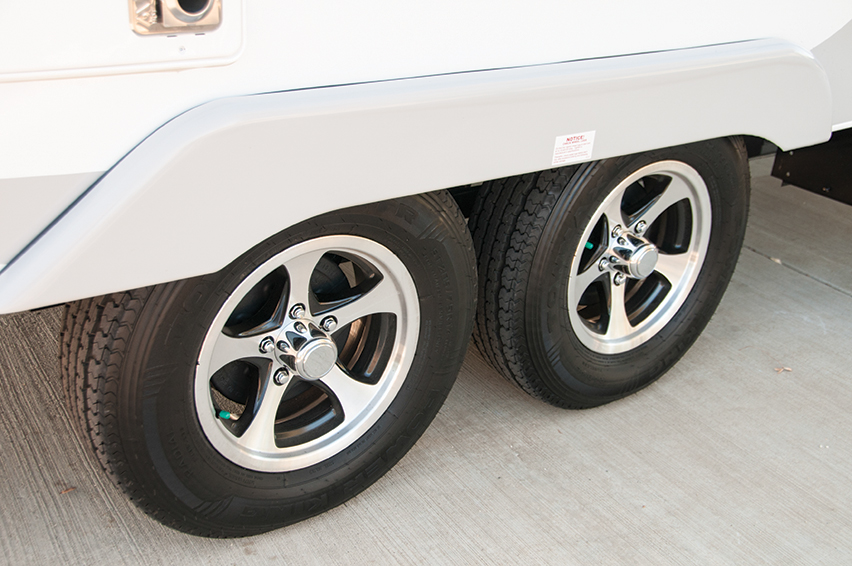
When trailer tires fail, they often damage surrounding fender skirts, sidewalls, wheel wells and trim. Note that these tires are filled with nitrogen, indicated by green valve caps.
Inflation pressures printed on passenger and other tire sidewalls are maximum pressures, which are necessary only at maximum-rated loads. Never arbitrarily reduce tire pressure just to get a softer ride, as this may lead to catastrophic tire failure. Always carry a reliable tire gauge, and if your vehicle has dual rear wheels, make sure the gauge has an offset double head that can reach both outer and inner dual-tire valves.
As a tire’s temperature increases, so does the pressure in the tire. Typically, for every 10-degree-Fahrenheit increase, a tire’s internal pressure will increase by 0.7 psi. Changes in altitude also affect tire-pressure readings. For a trip starting at sea level, pressures subsequently measured at 5,000 feet elevation would indicate about 2 to 3 psi higher. Conversely, descending from 5,000 feet to sea level would result in a similar apparent loss of pressure of about 2 to 3 psi. However, the differences above assume tire pressures are measured at the same temperatures.
Since tire pressures change about 1 psi for every 10-degree-Fahrenheit change in ambient temperature, tire pressure measured at lower altitudes will likely change when exposed to cooler temperatures associated with higher elevations. This means that, in many cases, differences in ambient temperature may come close to offsetting differences caused by a change in altitude. Drivers may want to simply set their cold tire pressures the morning after arriving at their higher or lower destination, and reset them again after they return home.
The proper way to determine how much pressure to run in each tire should be determined by weighing the fully loaded vehicle on a truck scale. The best scales provide individual wheel weights. To help determine the correct tire-inflation pressure for your vehicle’s tire loading, each tire manufacturer provides load-inflation tables specific to its products. These may be obtained at tire dealers for the brand and online at the manufacturers’ websites. Tire-inflation placards on the truck or RV reflect recommended pressures for the chassis.
Wear
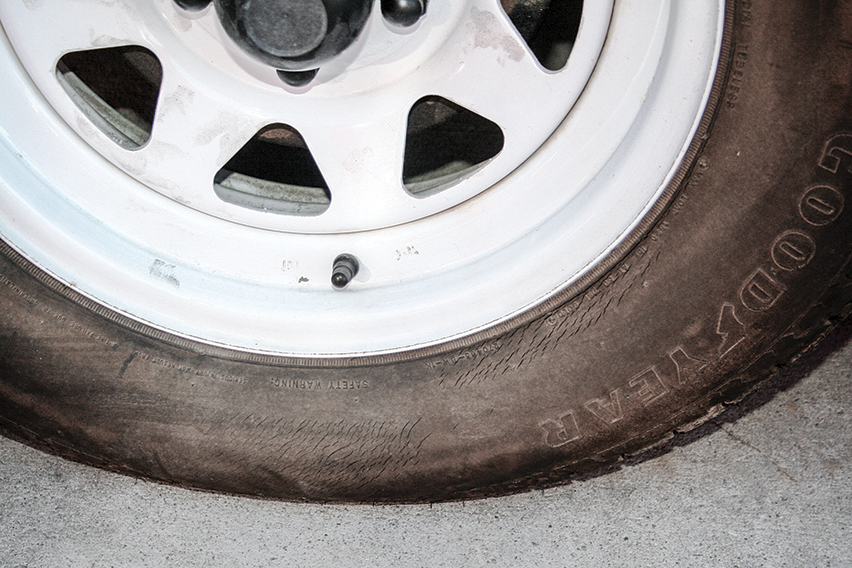
Old tires with visible cracking should be replaced to avoid failures.
Most states have laws regarding minimum allowable tread depth, and this should always be followed. On passenger-car tires, the wear limit is typically 2/32 inch. Laws may require that only the front tires on larger vehicles be replaced at a tread depth of 4/32 inch, while rears and passenger tires can be 2/32 inch. However, wet-weather braking and handling are significantly diminished with less than 4/32 inch of remaining tread. Tires should also be replaced if they show signs of bubbles, separation, significant weathering or other types of damage.
Rotation
Tire rotation can help keep tires wearing straighter and possibly make them last longer. If all of the tires are the same type, they can be rotated; just refer to the diagram in the owner’s manual. If there is a spare tire, and it is in good condition and compatible, it should also be rotated. However, for tow vehicles, if the rear tires have special deep-traction lugs and the fronts have a smoother highway tread, rotation is not recommended. Tire rotation on motorhomes can be expensive, and if the coach travels few miles and the tires are likely to need replacement due to age before the treads wear out, the cost may exceed the benefits.
Balancing
For best performance, tire and wheel assemblies should be balanced, including the trailer tires. Out-of-balance tires put excessive forces on suspension and steering components, and tend to cup and wear excessively at the heavy spot. Wheel balancing should be performed when new tires are mounted, after a flat repair and any time a tire is dismounted and remounted.
Load Range/Ply Ratings
The load range molded on a light-truck tire’s sidewall (such as D, E or F) is marked with the maximum weight it is designed to carry, along with the minimum pressure required to carry that weight. Load ranges increase in alphabetical order, so, for example, an E-rated tire will have a higher weight rating than a D-rated tire of the same size and can handle higher inflation pressures.
Current load ranges do not count the actual number of ply layers in a tire’s carcass. Rather, they indicate an equivalent strength relative to older bias-ply tires. Typical radial passenger-car tires have one or two body plies. LT tires (even 10-, 12- or 14-ply rated), have only two or three fabric plies or one steel-body ply. When changing tires, confirm that the load range marked on the new tire is equal to (or higher) than the load range on the original tire, and/or that the new tire’s rated load-carrying capacity meets (or exceeds) its share of the vehicle’s gross axle weight rating (gawr).
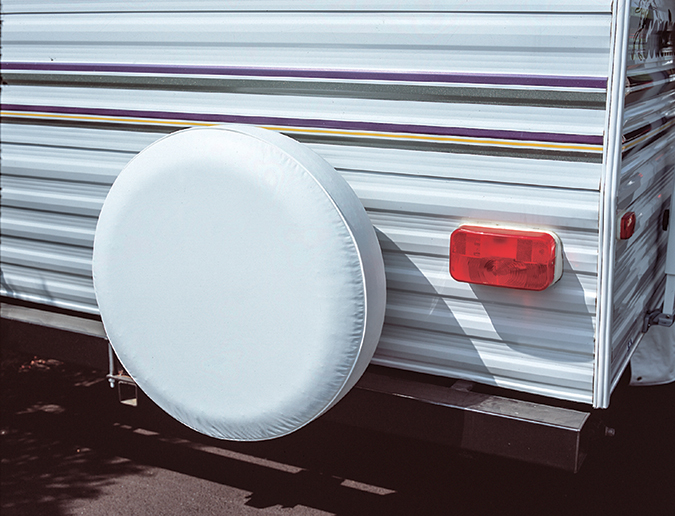
Spare-tire covers can help extend the useful life of the rubber by keeping the sunlight off.
|
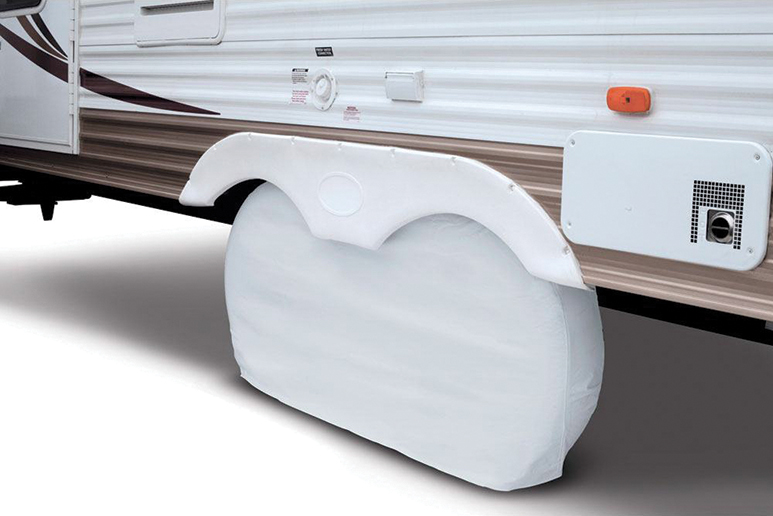
A set of tire covers is a good investment and should be put on when the RV sits in one place for a long time.
|
Wheels
Wheel manufacturers stamp wheels with the maximum-inflation pressure and maximum-rated weight they are designed to carry. When replacing wheels, always use those with ratings at least as high as the original equipment. Offset and backspacing must also be correct for a safe installation. Lug nuts or bolts should be tightened in a crisscross pattern to the manufacturer’s specified torque. Wheels should then be retorqued after driving for about 50 to 100 miles and before each trip and after extended storage.
Nitrogen Inflation
Green tire-valve caps denote the tires were inflated with nitrogen instead of atmospheric air. Nitrogen has some limited advantages over air, although no tire manufacturer requires the use of nitrogen. Atmospheric air contains about 79 percent nitrogen, and it’s impractical to inflate tires with 100 percent pure nitrogen, because the tire contains some air even when deflated. Therefore, if your vehicle’s tires have nitrogen in them, leave it in. Never run with lower pressure than needed due to an unavailability of nitrogen; use air to maintain pressure, if that’s what is available.
TPMS
Many blowouts occur because of a slow leak that allows tire pressure to drop while the vehicle is in motion, heating the tire to the point of failure. This can result in a dangerous loss of control, and even if a crash doesn’t occur, frequently there is vehicle damage caused by a flailing tire. Tire-pressure monitoring systems (TPMS) are available to track both the tow vehicle’s and trailer’s (or motorhome’s and dinghy vehicle’s) tire pressures. These provide peace of mind and greatly reduce the chance that low tire pressure will result in a blowout or worse. For a comparison of aftermarket TPMS devices, see page 36.
Valves
Low-pressure tire valves should be replaced each time tires are replaced. Tires that run high pressures require special tire valves, and valves used with dual tires must be designed to be accessible for filling and checking pressure. Special hoses extend the reach to inner dual-tire valves and make it easier to check and adjust pressure. However, these hoses and fittings are subject to leaks, and if a dual loses pressure while driving, it may overheat and fail catastrophically. Extended valve stems are also available and make checking and inflating tires much easier than factory stems. For safety, it’s best to use a TPMS when extensions are used.
Storage
Many RVs sit idle for months or longer. If possible, keep your RV in a cool, dry storage area away from direct sunlight and damaging UV rays. Tires deteriorate faster when exposed to sunlight and ozone, which is found in greater concentrations in polluted city air and near large electric motors, welders, etc. This causes cracking, weathering or “dry rot” — typically between the tread elements or on the tire’s sidewalls. Deterioration that extends to the cord, fabric or steel of the tire is a safety hazard.
Thoroughly clean tires with soap and water before storage. To help prevent cracking and flat spotting of the tires, move the RV periodically to bring protective tire compounds to the surface. Ideally, drive the RV long enough to get the tires warm. According to Goodyear, tires on RVs in storage should be inflated to the normal recommended pressure plus 25 percent (to allow for leakage loss), but don’t exceed the rim’s inflation capacity. Reset tire pressures before using the RV.
Tire covers keep sunlight off tires and slow UV damage, and may be purchased from RV dealers and Camping World. Use tire covers if you store your RV outdoors for extended periods. Tire manufacturers do not recommend the use of sidewall dressings that contain petroleum distillates because they contribute to rubber deterioration. However, some products such as 303 Aerospace Protectant have been noted to provide protection from sunlight and UV rays.
Tire Tips
- Keep a log of tire-pressure readings, singling out tires that lose pressure at a greater rate than normal, indicating a valve-stem leak or a puncture.
Keep a record of tire build dates and replace tires that are older than seven years. RV tires often age out before they wear out.
Severe underinflation can cause damage that is not visually apparent; any tire that appears to have been underinflated by 20 percent or more should be removed, unmounted and professionally inspected.
Longevity
The older a tire is, the greater the chance that it will need to be replaced due to deterioration. Tires eventually deteriorate to the point that they are unsafe. As a general rule, tires will last longer on vehicles that have been garaged or stored outdoors in the shade with the tires covered compared to those left exposed to sunlight.
Some manufacturers recommend tire replacement at about seven years. Michelin recommends its tires in use for five years or more should continue to be inspected by a specialist at least annually. The company says its tires should be good for 10 years, if they are stored indoors and don’t show signs of cracking or crazing.
Tire owners are encouraged to be aware not only of a tire’s visual condition and inflation pressure, but also of any change in dynamic performance such as increased air loss, noise or vibration, which could be indications that the tires need to be removed from service. While most tires will need replacement before they reach 10 years, Michelin recommends that any tires in service for 10 years or more from the date of manufacture, including spares, be replaced with new tires, even if such tires appear serviceable, and even if they have not reached the legal wear limit.
Upgrading Sizes
Some owners wish to increase tire sizes or switch to a higher load rating in the same size. Ride quality may be diminished due to the stiffer tire carcasses. Higher inflation pressures may be called for, and wheels must be rated for the higher pressure and be able to handle at least the expected maximum load. Tires having a larger or smaller rolling circumference will affect overall gearing. Changes greater than 3 percent may call for final-drive gearing changes. They can also affect ABS systems and speedometer accuracy.
To prevent damaging contact and friction when sidewalls bulge, dual wheels must have a certain distance between them, called dual spacing. On vehicles with dual rear wheels and original equipment tires and rims, dual spacing is sufficient. However, if wider tires or custom wheels are fitted, dual spacing must be checked against tire manufacturer specifications. Larger tires may also rub against the body or suspension and chassis parts.
Changing ST to LT
Many trailer owners have experienced multiple tire failures and have decided to use LT tires instead of ST types. If you change to LT tires, verify that they have sufficient load capacity for your travel trailer or fifth-wheel. Two popular LT tires used as replacements for ST tires are Goodyear’s G614 235/85R16 and Michelin’s XPS Rib LT235/85R16E tires. If you switch to a larger tire size to regain load capacity, check that there is sufficient clearance for larger tires. You may also need different (properly rated) wheels, which can make the cost of switching prohibitive.
Causes of Failure
Plenty of cheap, poorly made tires are on the market. However, many trailer tire blowouts are caused by conditions that owners can control, such as overloaded tires, improper inflation, incorrect alignment and uneven weight distribution. To determine if a tire is overloaded, find a truck scale that can weigh each individual wheel position. An axle may be within its gross axle weight rating (gawr), yet when tires at each axle end are weighed individually, you may find a tire that is overloaded.
Underinflated tires create extreme heat that leads to tire failure. A big reason tires fail is that they are not properly inflated for the load. The tire may appear normal on the outside, but the internal damage is not visible. Tires with internal damage caused by underinflation can fail catastrophically without warning. If you don’t know the exact load on the tires, inflate them to the maximum recommended pressure or the inflation pressure recommended for the maximum load listed on each tire’s sidewall. Overinflation may cause a harsher ride and more wear at the center of the tread, but this is preferable to catastrophic tire failure caused by underinflation.
Slideout rooms and full holding tanks often cause uneven weight distribution, both front-to-back and side-to-side. The only way to check this is by measuring individual wheel weights. To correct uneven weight distribution, it may be necessary to move heavy items and/or adjust the weight carried in tanks.
Final Thoughts
Be sure to check inflation frequently and consider getting a TPMS. Every RVer should carry a small portable 12-volt DC air compressor, or some other compressed air source, that can deliver enough pressure to top off tires when needed. Having your own compressor is especially handy, because tires should be inflated when cold, before driving.
Protect your vehicles’ tires by avoiding potholes, curbs and other hazards, watching for uneven or unusual tire wear and storing both the tow vehicle and RV properly to ensure the best tire life.




